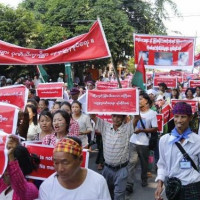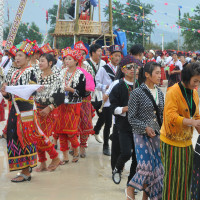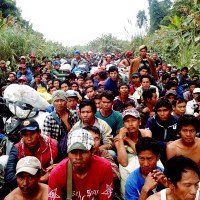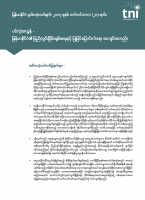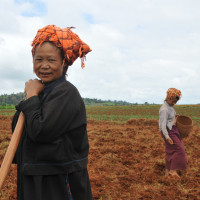မန္မာႏိုင္ငံ၏ ေျမလြတ္၊ ေျမလပ္ႏွင့္ ေျမရိုင္းစီမံခန္႔ခြဲေရးဥပေဒ အေကာင္အထည္ေဖာ္မႈ၊ တစ္ႏိုင္ငံလံုးအပစ္အခတ္ရပ္စဲေရးႏွင့္ ၿငိမ္းခ်မ္းေရးညွိႏိႈင္းေဆြးေႏြးမႈ အလားအလာ Jason Gelbort ၏ သံုးသပ္တင္ျပခ်က္
Topics
- Land Policy in Myanmar
- Myanmar Commentary
- Ethnic Conflict in Myanmar
ၿငိမ္းခ်မ္းေရး တိုးတက္ျဖစ္ထြန္းမႈကို အေထာက္အကူျပဳရန္အတြက္ လူထုလူတန္းစားမ်ား၏ ေျမ ယာရပိုင္ခြင့္အခြင့္အေရးမ်ားကို မျဖစ္မေနအကာအကြယ္ေပးရမည္။
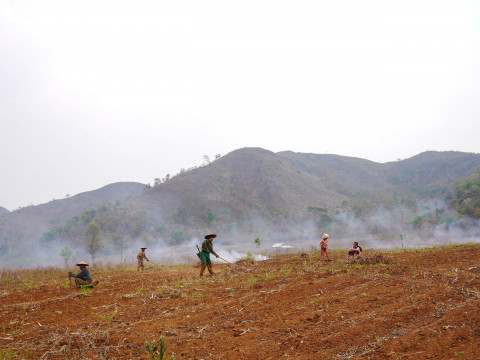
Jason Gelbort
ျမန္မာႏိုင္ငံေတာ္အစိုးရ၏ ေျမယာမူ၀ါဒအေပၚ ခ်ဥ္းကပ္မႈပံုစံသည္ ေျမယာပဋိပကၡမ်ား တိုးပြားလာ ေစၿပီး တရား၀င္ၿငိမ္းခ်မ္းေရး ေစ့စပ္ညွိႏိႈင္းရာ၌ လက္ရွိႀကံဳေတြ႔ရလ်က္ရွိသည့္ စိန္ေခၚမႈမ်ားကို ပိုမို ဖိတ္ေခၚလ်က္ရွိသည္။ အရပ္ဖက္လူမႈအဖြဲ႔အ စည္းမ်ားကလည္း လတ္တေလာျပင္ဆင္ခဲ့သည့္ ေျမလြတ္၊ ေျမလပ္ႏွင့္ ေျမရိုင္းစီမံခန္႔ခြဲေရးဥပေဒ (VFV ေျမယာဥပေဒ)ကို အေကာင္အထည္ေဖာ္ျခင္းျဖင့္ ေက်းလက္ေနလူထုလူတန္းစားမ်ားကို ၎တို႔၏ ဘိုးဘြားပိုင္နယ္ေျမမ်ားမွ ေနရပ္စြန္႔ခြာတိမ္းေရွာင္ရေစၿပီး ဓေလ့ထံုးတမ္းဆိုင္ရာ ေျမယာ ရပိုင္ခြင့္အခြင့္အေရးမ်ား ခ်ိႏွဲ႔အားနည္းသြားေစရန္ တြန္းအားေပးလိမ့္မည္ဟူသည့္ ေၾကာင္းက်ိဳးဆီ ေလ်ာ္သည့္ စိုးရိမ္ပူပန္မႈေပၚအေျခခံ၍ အေကာင္အထည္ေဖာ္မႈကို အျပင္းအထန္ကန္႔ကြက္လ်က္ ရွိသည္။ 1 ေနျပည္ေတာ္၏ ဥပေဒျပဳျပင္ေျပာင္းလဲမႈသည္ လက္ရွိၿငိမ္းခ်မ္းေရးလုပ္ငန္းစဥ္၏ ရည္ မွန္းခ်က္ႏွင့္ တစ္ႏိုင္ငံလံုးအပစ္အခတ္ရပ္စဲေရးသေဘာတူစာခ်ဳပ္(NCA)ပါ ကတိက၀တ္မ်ားႏွင့္ ဆန္႔က်င္ေသြဖယ္လ်က္ရွိေၾကာင္း ဤအခ်က္က သက္ေသျပလ်က္ရွိသည္။ ထို႔အျပင္ NCA ၌ သ ေဘာတူလက္မွတ္ ေရးထိုးထားျခင္းမရွိေသးသည့္ နယ္ေျမေဒသေပါင္းမ်ားစြာလည္း က်န္ရွိေနဆဲ ျဖစ္သည္။ ထို႔ေၾကာင့္ အစိုးရတစ္ရပ္အေနျဖင့္ အေျပာင္းအလဲဆီသို႔ ဦးတည္ခ်ဥ္းကပ္ရာ၌ ေျမယာ ရပိုင္ခြင့္ အခြင့္အေရးမ်ားကို ကာကြယ္ေစာင့္ေရွာက္ေပးရန္ႏွင့္ ၿငိမ္းခ်မ္းေရးတိုးတက္ျဖစ္ထြန္းလာ ေစမည့္ ယုံၾကည္မႈတိုးတက္ခိုင္မာလာေအာင္ တည္ေဆာက္သြားရန္ မျဖစ္မေနလိုအပ္ပါသည္။
ေနာက္ခံအက်ဥ္း - ေျမလြတ္၊ ေျမလပ္ႏွင့္ ေျမရိုင္းစီမံခန္႔ခြဲေရးဥပေဒအေပၚ အရပ္ဖက္လူမႈအဖြဲ႔အ စည္းမ်ား ၀ိုင္း၀န္းဆန္႔က်င္ကန္႔ကြက္မႈ
ရာေပါင္းမ်ားစြာေသာ အရပ္ဖက္လူမႈအဖြဲ႔အစည္းမ်ားသည္ ေျမယာပဋိပကၡႏွင့္ ေျမယာလုယူမႈကို အားေပးကူညီသည့္ ဥပေဒတစ္ရပ္ျဖစ္လာမည့္ အစိုးရ၏ VFV ေျမယာဥပေဒ အေကာင္အထည္ ေဖာ္မႈကို ဆန္႔က်င္ကန္႔ကြက္ရန္ စည္းရံုးလႈပ္ရွားလ်က္ရွိသည္။ သေဘာထားထုတ္ျပန္ေၾကညာ ခ်က္တစ္ခုအတြင္း ေျမလြတ္၊ ေျမလပ္ႏွင့္ ေျမရိုင္းေျမ စီမံခန္႔ခြဲေရး ဗဟိုေကာ္မတီ၏ ၂၀၁၈ ခုႏွစ္ ေအာက္တိုဘာလ ၃၀ ရက္ေန႔ အမိန္႔ေၾကညာခ်က္အရ ေျမလြတ္၊ ေျမလပ္ႏွင့္ ေျမရိုင္းအသံုးျပဳ လ်က္ရွိသည့္ မည္သူမဆို မွတ္ပံုတင္ၿပီးမွသာ ဆက္လက္အသံုးျပဳခြင့္ရရွိမည္ျဖစ္ေၾကာင္း ရွင္း လင္းေဖာ္ျပထားသည္။ 2 ဤေၾကညာခ်က္သည္ ျမန္မာႏုိင္ငံလူဦးေရ၏ ႀကီးမားသည့္လူအုပ္စုတစ္ ရပ္အတြက္ ဆိုးရြားလွသည့္ မေသခ်ာမေရရာမႈမ်ားစြာကို ေဆာင္က်ဥ္းလာခဲ့သည္။ ေျမကိုမွတ္ပံု တင္လိုက္ပါကလည္း ယင္းေျမႏွင့္ဆက္စပ္လ်က္ရွိသည့္ ၎တို႔၏ သမိုင္းအစဥ္အလာႏွင့္ ဓေလ့ ထံုးတမ္းဆိုင္ရာ ရပိုင္ခြင့္အခြင့္အေရးမ်ားကို ႏွစ္(၃၀)အသံုးျပဳခြင့္ႏွင့္ အလဲအထပ္ျပဳလုပ္ရေပ ေတာ့မည္။ မွတ္ပံုတင္ရန္ ပ်က္ကြက္ခဲ့ပါကလည္း ကန္ထုတ္ခံရႏိုင္သည့္ အရဲစြန္႔ရမႈအႏၱရာယ္ သို႔မဟုတ္ ေထာင္ဒဏ္ (၂)ႏွစ္ေသာ္လည္းေကာင္း ဒဏ္ေငြ(၅)သိန္းေသာ္လည္းေကာင္း ႏွစ္ရပ္စ လံုးေသာ္လည္းေကာင္း က်ခံရႏိုင္သည့္ ျပစ္ဒဏ္မ်ားက ေစာင့္ၾကိဳေနျပန္သည္။ အစိုးရမွ VFV အ ျဖစ္ သတ္မွတ္ႏိုင္သည့္ ေျမဧကေပါင္း ၄၅ သန္းေက်ာ္ရွိသည္ဟု ခန္႔မွန္းတြက္ခ်က္ထားရာ၌ ၈၂% ေသာ ေျမယာမ်ားသည္ တိုင္းရင္းသားျပည္နယ္မ်ား၌ တည္ရွိေနသျဖင့္ ႏိုင္ငံတစ္၀ွမ္းရွိ မေရမတြက္ႏိုင္သည့္ လူထုလူတန္းစားေပါင္းမ်ားစြာ၏ ရွင္သန္ေနထိုင္ေရးႏွင့္ အသက္ေမြး၀မ္း ေက်ာင္းလုပ္ငန္းမ်ား ျခိမ္းေျခာက္ခံေနရၿပီျဖစ္သည္။3
CSOs မ်ားက VFV ေျမယာဥပေဒမွ ရွိႏွင့္ၿပီးျဖစ္သည့္ ေျမယာလုပ္ပိုင္ခြင့္မ်ားအေပၚ ျခိမ္းေျခာက္ လာႏိုင္သည့္ ပံုစံမ်ားအျပင္ ေျမယာလုယူမႈကို အားေပးကူညီ၍ ေျမယာပဋိပကၡမ်ားကို ျမင့္တက္ လာေစႏိုင္သည့္ အလားအလာမ်ားကိုပါ ေထာက္ျပေျပာဆိုခဲ့ၾကသည္။4 အဖြဲ႔အစည္းေပါင္း သံုးရာ ႏွင့္ ေလးဆယ့္ေျခာက္ဖြဲ႔ ပါ၀င္လက္မွတ္ေရးထိုးထားသည့္ သေဘာထားထုတ္ျပန္ခ်က္၌ “ဤဥပ ေဒကို လက္ခံအတည္ျပဳမည့္အစား အေျခခံအက်ဆံုး ဦးစားေပးအေနျဖင့္ ဓေလ့ထံုးတမ္းဆိုင္ရာ အေလ့အထမ်ားႏွင့္ စုေပါင္းေျမယာအခြင့္အေရးမ်ားကို ထိထိေရာက္ေရာက္အသိအမွတ္ျပဳ၍ ေျမ ယာအေပၚ မွီခိုရွင္သန္ေနရသူမ်ား၏ အက်ိဳးစီးပြားမ်ားကို ေဘးဆီးရန္ကာေပးသင့္သည္”ဟု ေျပာ ဆိုထားသည္။5 ဤသေဘာထားထုတ္ျပန္ခ်က္ႏွင့္ မ်ားမၾကာေသးမီက ကခ်င္ႏွင့္ ရွမ္းျပည္နယ္ ေျမာက္ပိုင္းရွိ ျပည္တြင္းေနရပ္စြန္႔ခြာစစ္ေဘးတိမ္းေရွာင္သူမ်ား(IDPs)၏ သေဘာထားထုတ္ျပန္ ခ်က္အတြင္း၌ မိမိတို႔၏ ဘိုးဘြားပိုင္ေျမယာမ်ားကို ဆက္လက္ထိန္းသိမ္းႏိုင္ရန္ ႀကီးစြာေသာစိန္ ေခၚမႈအခက္အခဲမ်ားကို ႀကံဳေတြ႔ေနရၿပီးျဖစ္သည့္ ပဋိပကၡဒဏ္သင့္ ေနရပ္စြန္႔ခြာစစ္ေဘးတိမ္း ေရွာင္ေနၾကရသူမ်ားအေပၚ ဆိုးဆိုးရြားရြားထိခိုက္နစ္နာေစလိမ့္မည္ဟု မီးေမာင္းထိုးျပထားသည္။6
ဥပေဒျပင္ဆင္ခ်က္အတြင္း တိုင္းရင္းသားေဒသမ်ားရွိ ဓေလ့ထံုးတမ္းဆိုင္ရာ ေျမယာလုပ္ပိုင္ခြင့္စ နစ္မ်ားေအာက္၌ အသံုးျပဳလ်က္ရွိသည့္ ေျမယာမ်ားကို ေျမလြတ္၊ ေျမလပ္ႏွင့္ ေျမရိုင္းဥပေဒ ေအာက္မွ ကင္းလြတ္ခြင့္ျပဳသည္ဟု ေဖာ္ျပပါရွိသည္။ သို႔ေသာ္လည္း ကင္းလြတ္ခြင့္ကို မည္ကဲ့သို႔ သတ္မွတ္ဆံုးျဖတ္သြားမည္ျဖစ္ေၾကာင္း ေသခ်ာလမ္းညႊန္ထားျခင္းမရွိသလို ထိုကဲ့သို႔ေသာ ေျမယာအခြင့္အေရးမ်ားကို အကာအကြယ္ေပးရန္ ျမန္မာႏိုင္ငံ၏ ဥပေဒမ်ား သို႔မဟုတ္ တိုင္းရင္းသား အေျချပဳ အုပ္ခ်ဳပ္ေရးစနစ္မ်ားႏွင့္ ေပါင္းစပ္ညွိႏိႈင္းေဆာင္ရြက္မည့္ ဖြဲ႔စည္းတည္ေဆာက္ပံုအတြင္း မည္သည့္အကာအကြယ္ကိုမွ် ေလာက္ေလာက္လားလား အာမခံေပးထားျခင္းမရွိေပ။7 မိမိတို႔၏ ဓေလ့ထံုးတမ္းဆိုင္ရာ လုပ္ပိုင္ခြင့္အခြင့္အေရး ေတာင္းဆိုလ်က္ရွိသည့္ ရြာသူရြာသားမ်ားအေနျဖင့္ တစ္ဖက္သတ္စီရင္ခ်က္ခ်ခံရမည့္အျပင္ မိမိတို႔၏အခြင့္အေရးကို လက္လႊတ္ဆံုးရႈံးသြားႏိုင္သည့္ အရဲစြန္႔ရမႈအႏၱရာယ္မ်ားႏွင့္သာ အဆံုးသတ္သြားလိမ့္မည္ဟု ဆိုလိုျခင္းျဖစ္သည္။
ႏိုင္ငံေရးပါတီေပါင္း(၁၅)ပါတီပါ၀င္လ်က္ရွိသည့္ စည္းလံုးညီညြတ္ေသာ တိုင္းရင္းသားလူမ်ိဳးမ်ား မဟာမိတ္(UNA)ႏွင့္ ၎တို႔၏ မိတ္ဖက္အဖြဲ႔အစည္းမ်ားကလည္း ဤဥပေဒႏွင့္ပတ္သက္၍ ေပၚ ေပါက္လာမည့္ ျပႆနာရပ္မ်ားကို ရွင္းလင္းေဖာ္ျပထားသည့္ သေဘာထားေၾကညာခ်က္တစ္ ေစာင္ကို ထုတ္ျပန္ခဲ့ၾကသည္။ လက္ရွိအသံုးျပဳလ်က္ရွိသည့္ ေျမယာမ်ားကို မွတ္ပံုတင္ထားသည္ ျဖစ္ေစ၊ မွတ္တမ္းတင္ထားသည္ျဖစ္ေစ သို႔မဟုတ္ ေျမပံုထုတ္ၿပီးျဖစ္ေစ၊ မထုတ္ထားသည္ျဖစ္ေစ “ဓေလ့ထံုးတမ္းစနစ္ေအာက္ရွိ ေျမယာလုပ္ပိုင္ခြင့္ အခြင့္အေရးမ်ားႏွင့္ တိုင္းရင္းသားမ်ိဳးႏြယ္စု မ်ား၏ သက္ဆိုင္ရာေဒသအလိုက္ ဓေလ့ထံုးတမ္းအရ စီမံခန္႔ခြဲလ်က္ရွိသည့္ ေျမယာအေလ့အထ မ်ားကို တရား၀င္အသိအမွတ္ျပဳ၍ ကာကြယ္ေစာင့္ေရွာက္ေပးရန္” လိုအပ္လ်က္ရွိသည္ဟု UNA မွ လူသိရွင္ၾကား ရွင္းလင္းေျပာဆိုထားသည္။8 အရပ္ဖက္လူမႈအဖြဲ႔အစည္းမ်ားကလည္း လက္ရွိဥပ ေဒကို ပယ္ဖ်က္၍ ပူးေပါင္းပါ၀င္ခြင့္ရွိသည့္ ဥပေဒျပဳေရးလုပ္ငန္းစဥ္ႏွင့္ တည္ဆဲအမ်ိဳးသားေျမအ သံုးခ်မႈမူ၀ါဒတို႔အေပၚ အေျခခံတည္ေဆာက္ထားသည့္ ဖက္ဒရယ္ေျမယာဥပေဒတစ္ရပ္ျဖင့္ အစား ထိုးျပ႒ာန္းေပးရန္ တြန္းအားေပးေတာင္းဆိုလ်က္ရွိသည္။
VFV ဥပေဒႏွင့္ တစ္ႏိုင္ငံလံုးအပစ္အခတ္ရပ္စဲေရး သေဘာတူစာခ်ဳပ္ - အံေခ်ာ္လ်က္ရွိျခင္း
အစိုးရ၏ ေျမယာဥပေဒ ျပဳျပင္ေျပာင္းလဲေရးကို အေကာင္အထည္ေဖာ္ရာ၌ တစ္ႏိုင္ငံလံုးအပစ္ အခတ္ရပ္စဲေရး သေဘာတူစာခ်ဳပ္ေအာက္ရွိ မိမိတို႔၏ ကတိက၀တ္မ်ားကို အၿမဲတမ္းလိုလို မ်က္ ကြယ္ျပဳထားေလ့ရွိသျဖင့္ အျငင္းပြားဖြယ္ရာျဖစ္ေနပါသည္။ အနည္းဆံုး တိုင္းရင္းသားလက္နက္ ကိုင္ေတာ္လွန္ေရးအဖြဲ႔အစည္းေပါင္း(၂၀)မွ ဆယ္ဖြဲ႔သည္ အစိုးရ၊ တပ္မေတာ္ႏွင့္ လႊတ္ေတာ္တို႔ ႏွင့္ NCA သေဘာတူလက္မွတ္ ေရးထိုးခဲ့ၾကၿပီးေနာက္ လႊတ္ေတာ္မွ ယင္းသေဘာတူညီခ်က္ကို ဆက္လက္အတည္ျပဳခဲ့သည္။9 NCA စာသားအရ ခ်က္ျခင္းျမင္သာရန္ခဲယဥ္းသည့္ ေျမယာစီမံခန္႔ ခြဲမႈအတြက္ လက္မွတ္ေရးထိုးထားသည့္ EAO မ်ားႏွင့္ ညွိႏိႈင္းေဆာင္ရြက္ရန္ အစိုးရဖက္က သ ေဘာတူထားသည့္ နည္းလမ္းႏွစ္သြယ္ရွိသည္။ ပထမနည္းလမ္းမွာ ၾကားကာလအစီအစဥ္မ်ားႏွင့္ NCA စည္းေ၀းဆံုးျဖတ္ခ်က္မ်ားအားျဖင့္ ညွိႏိႈင္းေဆာင္ရြက္ရန္ႏွင့္ ဒုတိယနည္းလမ္းအေနျဖင့္ NCA ၌ ထပ္ေလာင္းအတည္ျပဳထားသည့္ ႏွစ္ဦးသေဘာတူ အပစ္အခတ္ရပ္စဲေရး သေဘာတူစာ ခ်ဳပ္မ်ားအားျဖင့္ ညွိႏိႈႈင္းေဆာင္ရြက္သြားရမည္ျဖစ္သည္။10
NCA ၏ ၾကားကာလ အစီအစဥ္မ်ားအခန္း၌ အစိုးရႏွင့္ EAO မ်ား ေပါင္းစပ္ညွိႏိႈင္းေဆာင္ရြက္ရန္ လိုအပ္သည့္ က႑မ်ားစာရင္းကို အက်ယ္တ၀င့္ရွင္းလင္းေဖာ္ျပထားသည္။ ဤအခန္း၌ ေနာက္ ဆံုးၿငိမ္းခ်မ္းေရး သေဘာတူညီခ်က္ကို အေကာင္အထည္မေဖာ္ေဆာင္ႏိုင္မီ တိုင္းရင္းသားနယ္ ေျမေဒသမ်ား၌ လက္ရွိက်င့္သံုးလ်က္ရွိသည့္ အုပ္ခ်ဳပ္ေရးစနစ္မ်ားကို အသိအမွတ္ျပဳ၍ အဆိုပါ အုပ္ခ်ဳပ္ေရးစနစ္မ်ားကို ထိပါးေႏွာက္ယွက္လာသည့္ လုပ္ေဆာင္ခ်က္မ်ားမွ အကာအကြယ္ေပး ရန္ ရည္ရြယ္ထားသည္။ NCA ၏ အပိုဒ္ခြဲ ၂၅(က-၂)၌ “သဘာ၀ပတ္၀န္းက်င္ထိန္းသိမ္းေရး”ကို ၾကားကာလအစီအစဥ္ေအာက္ရွိ နယ္ပယ္ေဒသတစ္ခုအျဖစ္ သတ္မွတ္ထားသည္။
NCA စည္းေ၀းဆံုးျဖတ္ခ်က္ မွတ္တမ္းမ်ားႏွင့္ NCA အပိုဒ္ ၃၀ ၌ ေျမယာႏွင့္ တိုက္ရိုက္ဆက္စပ္ သည့္ ကိစၥရပ္မ်ားကို ေဖာ္ျပထားသည္။ ဤအပိုဒ္အရ NCA အေကာင္အထည္ေဖာ္မႈအတြင္း သက္ဆိုင္ရာ စည္းေ၀းဆံုးျဖတ္ခ်က္မွတ္တမ္းမ်ားကိုပါ ထည့္သြင္းေဖာ္ေဆာင္ရန္ လိုအပ္သည္။11 NCA စည္းေ၀းဆံုးျဖတ္ခ်က္ အမွတ္(၂၅)၌ ၾကားကာလအစီအစဥ္မ်ားကို မည္သို႔အဓိပၸာယ္ဖြင့္ဆို ရမည္ျဖစ္ေၾကာင္း ရွင္းရွင္းလင္းလင္းလမ္းညႊန္ေပးထားသည္။ “ပုဒ္မ ၂၅(က-၂)တြင္ ‘သဘာ၀ပတ္ ၀န္းက်င္ထိန္းသိမ္းေစာင့္ေရွာက္ေရး’ဆိုရာ၌ EAO မ်ားအဆိုျပဳသည့္အတိုင္း ေျမယာႏွင့္ သယံဇာတအရင္းအျမစ္စီမံခန္႔ခြဲေရးအတြက္ ညွိႏိႈင္းေဆာင္ရြက္သြားရမည္”ဟု ရွင္းလင္းေဖာ္ျပထားသည္။12 ဆိုလိုသည္မွာ NCA ၾကားကာလ အစီအစဥ္မ်ားကို အေကာင္အထည္ေဖာ္ရာ၌ ေျမယာစီမံခန္႔ခြဲေရးပါ၀င္လ်က္ရွိၿပီး တိုင္းရင္းသားမ်ိဳးႏြယ္စုမ်ား၏ ရွိရင္းစြဲအုပ္ခ်ဳပ္စီမံေရး သို႔မဟုတ္ အက်ိဳးစီးပြားမ်ားႏွင့္ ၀ိေရာဓိျဖစ္ေစရန္ အစိုးရဖက္မွ တစ္ဖက္သတ္ျပဳမူေဆာင္ရြက္ျခင္းမရွိေစရဟု ဆိုလိုျခင္းျဖစ္သည္။ ဤအခ်က္သည္ အပစ္အခတ္ရပ္စဲထားသည့္ နယ္ေျမေဒသအားလံုး၌ သက္ေရာက္အက်ံဳး၀င္လ်က္ရွိၿပီး အထူးသျဖင့္ ဓေလ့ထံုးတမ္းဆိုင္ရာ လုပ္ပိုင္ခြင့္စနစ္မ်ားကို အသိအမွတ္ျပဳ အကာအကြယ္ေပးထားသည့္ ကိုယ္ပိုင္ေျမယာမူ၀ါဒျဖင့္ လည္ပတ္လ်က္ရွိသည့္ KNU ထိန္းခ်ဳပ္နယ္ေျမမ်ား သို႔မဟုတ္ လႊမ္းမိုးထားသည့္နယ္ေျမေဒသမ်ားသည္လည္း အပါအ၀င္ျဖစ္ သည္။13
ထို႔အျပင္ NCA သည္ အပစ္အခတ္ရပ္စဲေရး လက္မွတ္ေရးထိုးထားသည့္ EAO မ်ားႏွင့္ ႏွစ္ဦးသ ေဘာတူခ်ဳပ္ဆိုထားသည့္ ကနဦးစာခ်ဳပ္အတြင္း ေဖာ္ျပထားသည့္ ေျမယာဆိုင္ရာ ကိစၥရပ္မ်ားအား လံုးကိုပါ လႊမ္းျခံဳမႈရွိသည္။ NCA ၌ အဖြဲ႔၀င္မ်ားအား ၎တို႔၏ ႏွစ္ဦးသေဘာတူခ်ဳပ္ဆိုထားခဲ့သည့္ အပစ္အခတ္ရပ္စဲေရးကို ဆက္လက္အေကာင္အထည္ေဖာ္ရန္ အားေပးတိုက္တြန္းေၾကာင္း ႏွစ္ ႀကိမ္တိတိေဖာ္ျပထားသည္။စကားခ်ီးပိုင္း၌ NCA သည္ “ျပည္ေထာင္စုသမၼတျမန္မာႏိုင္ငံေတာ္ႏွင့္ တိုင္းရင္းသားလက္နက္ကိုင္အဖြဲ႔အစည္းမ်ားအၾကား ခ်ဳပ္ဆိုထားသည့္ ယခင္သေဘာတူစာခ်ဳပ္ မ်ားအားလံုးကို အသိအမွတ္ျပဳ၍ ထပ္ေလာင္းခိုင္မာေစရန္ ထပ္မံအတည္ျပဳသည္”ဟု ေဖာ္ျပထား ပါသည္။ ပုဒ္မ (၂-ဂ)တြင္ အဖြဲ႔၀င္မ်ားသည္ “ျပည္ေထာင္စုသမၼတျမန္မာႏိုင္ငံေတာ္ႏွင့္ တိုင္းရင္း သားလက္နက္ကိုင္အဖြဲ႔အစည္းမ်ားအၾကား ခ်ဳပ္ဆိုထားသည့္ ယခင္သေဘာတူညီခ်က္မ်ားအား လံုးႏွင့္ ကတိက၀တ္မ်ားအားလံုးကို ထပ္ေလာင္းအတည္ျပဳသည္”ဟု ပါရွိသည္။ မြန္ျပည္သစ္ ပါတီ(NMSP)ႏွင့္ ျပည္ေထာင္စုအဆင့္ႏွစ္ဖက္အပစ္အခတ္ရပ္စဲေရး သေဘာတူစာခ်ဳပ္၌ “လူထု၏ ေျမယာဆိုင္ရာ ကိစၥရပ္မ်ားအတြက္ ညွိႏိႈင္းေဆာင္ရြက္၍ အေျဖရွာသြားရန္” သေဘာတူသည္ဟု ေဖာ္ျပထားသျဖင့္ ဤအခ်က္မ်ားသည္ ေျမယာအတြက္ အလြန္အေရးႀကီးသည့္ ကိစၥရပ္မ်ားျဖစ္ သည္။14 ၾကားကာလအစီအစဥ္အခန္း၌လည္း အလားတူပင္ ေျမယာဆိုင္ရာ ကိစၥရပ္မ်ားအတြက္ အစိုးရအေနျဖင့္ သက္ဆိုင္ရာ EAO မ်ားႏွင့္ ညွိႏိႈင္းေဆာင္ရြက္သြားရမည္ဟုပါရွိသည္။15
ေျမယာဥပေဒ ျပဳျပင္ေျပာင္းလဲေရးသည္ ၿငိမ္းခ်မ္းေရးေဖာ္ေဆာင္ရာ၌ ရင္ဆုိင္ႀကံဳေတြ႔ေနရသည့္ ပိုမိုႀကီးမားက်ယ္ျပန္႔သည့္ စိန္ေခၚမႈမ်ားကို ကိုယ္စားျပဳထင္ဟပ္ေစလ်က္ရွိသည္။
VFV ဥပေဒ အေကာင္အထည္ေဖာ္မႈႏွင့္ ပတ္သက္သည့္ ရပ္ရြာလူထုလူတန္းစားမ်ား၏ အခြင့္အ ေရးမ်ားႏွင့္ အသက္ေမြး၀မ္းေက်ာင္းလုပ္ငန္းမ်ားအေပၚ သိသိသာသာ စိုးရိမ္ပူပန္မႈ ျမင့္တက္လာရံု မွ်မက ေနျပည္ေတာ္ရွိ ေျမယာဥပေဒျပဳျပင္ေျပာင္းလဲေရးႏွင့္ အပစ္အခတ္ရပ္စဲေရးေဖာ္ေဆာင္ သည့္ လုပ္ငန္းစဥ္အၾကား ဆက္စပ္မႈေပ်ာက္ဆံုးေနျခင္းကလည္း အဓြန္႔ရွည္တည္တံ့ခိုင္ၿမဲသည့္ ၿငိမ္းခ်မ္းေရးရရွိေစရန္ ေစ့စပ္ညွိႏိႈင္းလ်က္ရွိသည့္ ႀကိဳးပမ္းအားထုတ္မႈမ်ားႏွင့္ ၂၀၂၀ ခုႏွစ္ အေထြ ေထြေရြးေကာက္ပြဲႏွင့္ ပတ္သက္သည့္ NLD ၏ ေရြးေကာက္ပြဲေမွ်ာ္မွန္းခ်က္မ်ားအတြက္ ႀကီးစြာ ေသာ အခက္အခဲျပႆနာမ်ားကို ေပၚေပါက္လာေစမည့္ လက္ေတြ႔ျဖစ္ရပ္တစ္ခုအျဖစ္ သာဓက ျပဆိုလ်က္ရွိသည္။ ကရင္ၿငိမ္းခ်မ္းေရးေထာက္ကူျပဳကြန္ရက္၏ ၂၀၁၈ ခုႏွစ္ ဇူလိုင္လထုတ္ အစီ ရင္ခံစာ၌ လတ္တေလာ VFV ေျမယာဥပေဒျပင္ဆင္ခ်က္မ်ားႏွင့္ အေကာင္အထည္ေဖာ္ေဆာင္မႈ မတိုင္မီကတည္းက ဤျပႆနာကို ေအာက္ပါအတိုင္း ႀကိဳတင္မီးေမာင္းထိုးျပခဲ့ၿပီးျဖစ္သည္။
လက္ရွိလႊတ္ေတာ္တြင္း ျဖစ္ေပၚလ်က္ရွိသည့္ ေျမယာဆိုင္ရာ ဥပေဒျပဳျပင္ေျပာင္းလဲေရး လုပ္ငန္းစဥ္သည္ ႏိုင္ငံတစ္နံတစ္လ်ား နက္နက္ရိႈင္းရိႈင္းအျမစ္တြယ္လ်က္ရွိသည့္ ေျမယာ ဆိုင္ရာ ပဋိပကၡမ်ားကို ေျပလည္သြားေစႏိုင္ၿပီး ႏိုင္ငံတြင္း အဓြန္႔ရွည္တည္တံ့ခိုင္ၿမဲသည့္ ၿငိမ္းခ်မ္းေရးျဖစ္ေပၚလာေစရန္ အုတ္ျမစ္ခ်ေပးႏိုင္သည့္ အခြင့္အလမ္းမ်ားကို လံုး၀မ်က္ ကြယ္ျပဳရာ ေရာက္ေနပါသည္။ တိုင္းရင္းသားလူထုလူတန္းစားမ်ားက အေရးပါလွသည့္ ဤကိစၥရပ္ကို ၿငိမ္းခ်မ္းေရးညွိႏိႈင္းေဆြးေႏြးမႈ လုပ္ငန္းစဥ္အားျဖင့္ ကိုင္တြယ္ေျဖရွင္းႏိုင္ေစ ရန္ ႀကိဳးပမ္းအားထုတ္လ်က္ရွိသည္။ သို႔ေသာ္လည္း ေျမယာဆိုင္ရာ ဥပေဒမူေဘာင္မ်ား ႏွင့္ ပတ္သက္သည့္ လႊတ္ေတာ္တြင္း ျပဳျပင္ေျပာင္းလဲေရး လုပ္ငန္းမ်ားအားျဖင့္ ဗဟိုဦးစီး ေျမယာထိန္းခ်ဳပ္ေရးစနစ္တစ္ရပ္ကို ဆက္လက္ေဖာ္ေဆာင္ေနျခင္းက ၿငိမ္းခ်မ္းေရးညွိႏိႈင္း ေဆြးေႏြးမႈ လုပ္ငန္းစဥ္ႏွင့္ ေျမယာအေရးကိစၥအတြက္ သာတူညီမွ်ရွိ၍ တရားမွ်တမႈရွိ သည့္ ေျဖရွင္းေရးနည္းလမ္းမ်ားဆီသို႔ ဦးတည္သြားေစႏိုင္သည့္ အခြင့္အလမ္းမ်ားအား လံုးကို ကေသာင္းကနင္းျဖစ္သြားေစခဲ့သည္။16
NCA အေကာင္အထည္ေဖာ္ေရး လုပ္ငန္းစဥ္၌ ဆိုးရြားျပင္းထန္သည့္ စိန္ေခၚမႈမ်ားကို ရင္ဆိုင္ ၾကံဳေတြ႔ရလ်က္ရွိသည္။ အစိုးရ၊ တပ္မေတာ္ႏွင့္ NCA အဖြဲ႔၀င္ တိုင္းရင္းသားလက္နက္ကိုင္အ ဖြဲ႔၀င္ ထိပ္တန္းေခါင္းေဆာင္မ်ား၏ ေအာက္တိုဘာလ ၁၅-၁၆ ရက္ေန႔ ေနျပည္ေတာ္စည္းေ၀း ပြဲေနာက္ပိုင္း KNU ႏွင့္ သွ်မ္းျပည္ျပန္လည္ထူေထာင္ေရးေကာင္စီ(RCSS)မ်ားက ၎တို႔အေန ျဖင့္ လက္ရွိ NCA ဆိုင္ရာ ေတြ႔ဆံုစည္းေ၀းပြဲမ်ား၌ ယာယီအေနျဖင့္ ပါ၀င္ေဆာင္ရြက္မႈကို ဆိုင္းငံ့ထားရန္ ဆံုးျဖတ္ခဲ့သည္။ ဤႏွစ္ဖြဲ႔သည္ NCA လက္မွတ္ေရးထိုးခဲ့သည့္ တိုင္းရင္းသား လက္နက္ကိုင္အဖြဲ႔အစည္းမ်ားအနက္ အင္အားအႀကီးဆံုးျဖစ္သည္။ သို႔ေသာ္လည္း ၿငိမ္းခ်မ္းေရး ေတြ႔ဆံုေဆြးေႏြးမႈလုပ္ငန္းစဥ္ႏွင့္ ပူးတြဲေစာင့္ၾကည့္ေရးေကာ္မတီမ်ားကို အေကာင္အထည္ေဖာ္ သည့္ပံုစံသည္ အဓြန္႔ရွည္တည္တံ့ခိုင္ၿမဲသည့္ ၿငိမ္းခ်မ္းေရး သို႔မဟုတ္ အႏွစ္သာရျပည့္၀သည့္ အ ေျပာင္းအလဲဆီသို႔ ေခၚေဆာင္သြားႏိုင္လိမ့္မည္မဟုတ္ဟု စိုးရိမ္တႀကီး ထုတ္ေဖာ္ေျပာဆိုခဲ့ၾက သည္။ အဖြဲ႔အစည္းႏွစ္ရပ္စလံုးက လက္ရွိတရား၀င္လုပ္ငန္းစဥ္အတြင္း အဓိကရင္ဆိုင္ႀကံဳေတြ႔ရ လ်က္ရွိသည့္ ျပႆနာသည္ NCA ပါ စည္းမ်ဥ္းစည္းကမ္းမ်ားအေပၚ ဘံုနားလည္သေဘာေပါက္မႈ ကင္းမဲ့ေနျခင္းႏွင့္ အဖြဲ႔၀င္မ်ားအားလံုး သေဘာတူညီခ်က္(ႏွင့္ ႏွစ္ဦးသေဘာတူစာခ်ဳပ္မ်ား)ကို ထိထိေရာက္ေရာက္ အေကာင္အထည္ေဖာ္ရန္ ပ်က္ကြက္ေနျခင္းျဖစ္သည္ဟု ေျပာဆိုခဲ့သည္။17
အရပ္ဖက္လူမႈအဖြဲ႔အစည္းမ်ားကလည္း ေျမယာဥပေဒမ်ားကို စည္းၾကပ္ေဖာ္ေဆာင္ျခင္းသည္ ၿငိမ္းခ်မ္းေရးေဖာ္ေဆာင္ရန္ ကတိျပဳထားသည့္ ဖက္ဒရယ္စနစ္ဆီသို႔ ဦးတည္ရမည့္အစား ဗဟို၌ သာ အာဏာမ်ားကို စုေ၀းထားရွိလိုသည့္ သေဘာထားကို ကိုယ္စားျပဳထင္ဟပ္လ်က္ရွိသည္ဟု ထုတ္ေဖာ္ေျပာဆိုခဲ့ၾကသည္။18 တစ္ခ်ိန္တည္းမွာပင္ လက္နက္ကိုင္ပဋိပကၡ ဆက္လက္ျဖစ္ပြားေန ဆဲျဖစ္ၿပီး NCA ၌ ပါ၀င္လက္မွတ္ေရးထိုးရန္ ဖိတ္ေခၚခံရျခင္းမရွိသည့္ သို႔မဟုတ္ ျပန္လည္သံုး သပ္ရန္ သို႔မဟုတ္ ျပဳျပင္ေျပာင္းလဲရန္ လိုအပ္သည္ဟုဆိုကာ ျငင္းပယ္ခံထားရသည့္ နယ္ေျမေဒ သမ်ား က်န္ရွိေနဆဲျဖစ္သည္။ သို႔ျဖစ္၍ ၿငိမ္းခ်မ္းေရးစကား၀ိုင္း၌ ယံုၾကည္မႈကို ျပန္လည္တည္ ေဆာက္ရန္ ေနျပည္ေတာ္ရွိ သက္ဆိုင္ရာအစိုးရအဖြဲ႔အစည္းမ်ားႏွင့္ အရပ္ဖက္လူမႈအဖြဲ႔အစည္း မ်ားႏွင့္ တိုင္းရင္းသားျပည္နယ္ေဒသမ်ား၌ လုပ္ကိုင္ေဆာင္ရြက္လ်က္ရွိသူမ်ားအၾကား ၾကားကာ လအစီအစဥ္မ်ားႏွင့္ ႏွစ္ဖက္အပစ္အခတ္ရပ္စဲေရး သေဘာတူစာခ်ဳပ္မ်ား အေကာင္အထည္ေဖာ္ ေရးကိစၥရပ္မ်ားအပါအ၀င္ ယခုထက္ပို၍ က်ယ္က်ယ္ျပန္႔ျပန္႔ ထိေတြ႔ဆက္ဆံရန္ႏွင့္ ေပါင္းစပ္ ညွိႏိႈင္းေဆာင္ရြက္ရန္ အေရးတႀကီးလိုအပ္ေနၿပီျဖစ္သည္။
အလားတူပင္ ေလာေလာလတ္လတ္ က်င္းပခဲ့သည့္ ၾကားျဖတ္ေရြးေကာက္ပြဲအတြင္း ၿပိဳင္ဆိုင္မႈ ျပင္းထန္သည့္ ကိုယ္စားလွယ္ေနရာ ၁၃ ခုအနက္ NLD မွ ကိုယ္စားလွယ္ေနရာ (၇)ခုကိုသာ အ ႏိုင္ရရွိခဲ့ျခင္းကလည္း ပါတီအေနျဖင့္ အစိုးရႏွင့္ ျပည္ေထာင္စုလႊတ္ေတာ္မ်ားအတြင္းရွိ မိမိတို႔၏ အမ်ားစုေနရာကို လက္လႊတ္ဆံုးရႈံးရႏိုင္သည့္ အရဲစြန္႔ရမႈအႏၱရာယ္ရွိေနေၾကာင္း ေပၚလြင္ထင္ရွား လ်က္ရွိသည္။ NLD သည္ အစိုးရတစ္ရပ္အေနျဖင့္ အာဏာပိုင္ဆိုင္ထားရံုမွ်မက မူ၀ါဒမ်ားကို ထိန္းေက်ာင္းေမာင္းႏွင္ႏိုင္သည့္ လႊတ္ေတာ္ကိုယ္စားလွယ္ေနရာအမ်ားစုကိုလည္း ရရွိထားသျဖင့္ အရပ္ဖက္လူမႈအဖြဲ႔အစည္း အင္အားစုမ်ားႏွင့္ ကြန္ရက္မ်ား၏ တိုက္တြန္းအႀကံျပဳခ်က္မ်ားႏွင့္အညီ ဓေလ့ထံုးတမ္းဆိုင္ရာ ေျမယာလုပ္ပိုင္ခြင့္စနစ္ အာမခံခ်က္ရွိေအာင္ အားေပးျမွင့္တင္မႈအပါအ၀င္ တစ္ႏိုင္ငံလံုးရွိ လူထုလူတန္းစားမ်ား၏ အခြင့္အေရးမ်ားကို အားေပးအားေျမွာက္ျပဳရန္ အဆိုပါအာ ဏာမ်ားကို ဂရုတစိုက္အသံုးခ်သင့္ပါသည္။ ထို႔အျပင္ အပစ္အခတ္ရပ္စဲေရး သေဘာတူစာခ်ဳပ္ မ်ား၏ အႏွစ္သာရ သို႔မဟုတ္ စာသားမ်ားကို ယုတ္ေလ်ာ့ပ်က္ျပယ္သြားျခင္းမရွိေစရန္ အကာအ ကြယ္ေပး၍ အပစ္အခတ္ရပ္စဲေရးေဖာ္ေဆာင္ရန္ ေၾကြးေၾကာ္ထားသည့္ မိမိတို႔၏ သံဓိ႒ာန္မ်ားကို ေလ်ာ္ကန္သင့္ျမတ္စြာ လိုက္နာေစာင့္ထိန္းမႈရွိေအာင္ ၾကပ္မတ္ထိန္းေက်ာင္းေပးသင့္ပါသည္။ ထို႔ အျပင္ ဥပေဒပိုင္းဆိုင္ရာ ျပဳျပင္ေျပာင္းလဲေရး လုပ္ငန္းမ်ားႏွင့္ ၿငိမ္းခ်မ္းေရးညွိႏိႈင္းေဆြးေႏြးမႈမ်ား အတြက္ေပးအပ္သည့္ ႏိုင္ငံတကာမွ နည္းပညာအကူအညီသည္ အပစ္အခတ္ရပ္စဲေရးႏွင့္ တိုင္း ရင္းသားမ်ိဳးႏြယ္စုမ်ား၏ အုပ္ခ်ဳပ္ေရးလုပ္ငန္းမ်ားအပါအ၀င္ ႏို္င္ငံ၏ အျခားဥပေဒႏွင့္ အုပ္ခ်ဳပ္စီမံ ေရးမူေဘာင္ဆိုင္ရာ ကိစၥရပ္မ်ားႏွင့္ ႏိုင္ငံေရးျပဳျပင္ေျပာင္းလဲမႈလုပ္ငန္းမ်ားကိုပါ လႊမ္းျခံဳထင္ဟပ္မႈ ရွိရန္ မျဖစ္မေနလိုအပ္ပါသည္။ ၿငိမ္းခ်မ္းေရးလုပ္ငန္းစဥ္ ယိမ္းယိုင္ၿပိဳလဲလာေနၿပီျဖစ္ရာ အဘယ္ ေၾကာင့္ တိုးတက္မႈဆိတ္သုဥ္း၍ အခက္အခဲမ်ားျဖင့္သာ စခန္းသြားေနရေၾကာင္း အင္အားစုမ်ား အားလံုး ဆင္ျခင္သံုးသပ္ရမည့္အခ်ိန္ က်ေရာက္လာၿပီျဖစ္သည္။ ယင္း၌ ေျမယာျပဳျပင္ေျပာင္းလဲ ေရးႏွင့္ ဥပေဒစည္းၾကပ္ေဖာ္ေဆာင္မႈေၾကာင့္ အေျခအေနမ်ား ပိုမုိဆိုးရြားလာျခင္းမရွိေၾကာင္း ေသ ခ်ာေအာင္ေဆာင္ရြက္ရန္လည္း လိုအပ္လ်က္ရွိသည္။ ေျမယာသည္ ျမန္မာႏိုင္ငံ၏ အနာဂတ္အ တြက္ အဓိကအက်ဆံုး ေသာ့ခ်က္တစ္ခုျဖစ္သည္။
Jason Gelbort သည္ ၂၀၁၃ ခုႏွစ္မွစ၍ တိုင္းရင္းသားအင္အားစုမ်ားအား ၿငိမ္းခ်မ္းေရးဆိုင္ရာ ကိစၥရပ္မ်ားအတြက္ အႀကံေပးလာခဲ့သည့္ ႏိုင္ငံတကာေရွ႕ေနတစ္ဦးျဖစ္သည္။
References
1 Vacant, Fallow and Virgin Land Law (amended 11 September 2018, by Pyidaungsu Hluttaw Law No.24). Forest Trends conducted a legal analysis of the law prior to the recent amendments in 2012. Food Security Working Group’s Land Core Group, “Legal Review of Recently Enacted Farmland Law and Vacant, Fallow and Virgin Lands Management Law” (November 2012), available at: https://www.forest-trends.org/wp-content/uploads/imported/fswg_lcg_legal-review-of-farmland-law-and-vacant-fallow-and-virgin-land-management-law-nov-2012-eng-2-pdf.pdf.
2 Land In Our Hands, “Statement on the Opening of the Vacant, Fallow & Virgin Land Management Central Committee for Applying VFV Lands”, available at: https://progressivevoicemyanmar.org/2018/11/06/statement-on-the-opening-of-the-vacant-fallow-virgin-land-management-central-committee-for-applying-vfv-lands/.
3 See Land In Our Hands, “Statement on the Opening”.
4 The statements cited here present many of these concerns. For information on land grabbing and land conflicts, see, e.g., Land In Our Hands Network, “Destroying People’s Lives: The Impact of Land Grabbing on communities in Myanmar” (December 2015), available at: https://www.tni.org/files/article-downloads/lioh_research_report_eng_0.pdf; and Human Rights Watch, “Nothing for Our Land: Impact of Land Confiscation on Farmers in Myanmar” (2018), available at: https://www.hrw.org/sites/default/files/report_pdf/burma0718_web2.pdf. A recent randomized survey in Karen areas found that land grabbing was the most common human rights abuse since the 2012 bilateral ceasefires and that land-grabbing cases occurred almost exclusively in government-controlled and mixed-controlled areas. Saferworld and Karen Peace Support Network, “Security, justice and governance in southeast Myanmar: A knowledge, attitudes and practices survey in Karen ceasefire areas” (October 2018), pp.66-69.
5 “Civil Society Organizations’ Statement on the Vacant, Fallow & Virgin Land Management 2018 and related announcement”, 16 November 2018, (signed by 346 CSOs), available at: https://www.facebook.com/landinourhands/posts/2264079397202697. See also, "Letter of concern regarding implementation of the Vacant, Fallow and Virgin Lands Management Law (2012) as Amended by The Law Amending the Vacant, Fallow and Virgin Lands Management Law (2018)”, 16 November 2018, (signed by 41 INGOs and CSOs), available at: https://reliefweb.int/sites/reliefweb.int/files/resources/Final%20VFV%20letter%20to%20CC%20English.pdf. Other civil society organizations continue to issue statements. See, e.g., statements by the Karenni Land Seminar, 5 December 2018, and by four Kayan (KNP, KyWO, KNGY, KLCC) organizations, 5 December 2018.
6 “Statement on 2018 VFV law by IDPs from Kachin and Northern Shan state” (26 November 2018), available at: https://progressivevoicemyanmar.org/2018/11/26/statement-on-2018-vfv-law-by-idps-from-kachin-and-northern-shan-state/. There have been multiple reports of Kachin IDPs’ land being grabbed, especially for banana plantations. See, e.g., Htun Khaing, “Kachin IDPs fear land grabs in the villages they once called home” Frontier Myanmar (19 January 2018), available at: https://frontiermyanmar.net/en/kachin-idps-fear-land-grabs-in-the-villages-they-once-called-home. The Kachin Independence Organization issued a statement opposing the land grabs of IDPs’ lands. Central Committee Kachin Independence Organization, “Statement”, 25 November 2017. The concerns raised by displaced persons in northern Myanmar also apply to IDPs and refugees from other areas of the country.
7 See Ben Dunant, “Why a land law change is sparking fears of mass evictions”, Frontier Myanmar, 19 November 2018.
8 The United Nationalities Alliance and its Partner Organizations, “Joint Statement of the United Nationalities Alliance (UNA) and its Sister Organizations on the Vacant, Fallow & Virgin Land Management Law” (November 2018), available at: https://www.facebook.com/UnitedNationalitiesAlliance/posts/1135254689975656.
9 “Two new signatories become members of NCA”, Global New Light of Myanmar, 1 March 2018.
10 "The Nationwide Ceasefire Agreement Between the Government of the Republic of the Union of Myanmar and the Ethnic Armed Organizations (15 October 2015)", available at: https://peacemaker.un.org/sites/peacemaker.un.org/files/MM_151510_NCAAgreement.pdf.
11 “We agree that, in consultation with each other, decisions contained in the agreed meeting minutes taken during negotiations for the Nationwide Ceasefire Agreement shall be referred to in the implementation of the Agreement.” NCA, article 30.
12 In addition to land, women’s participation in the political dialogue and education programs are key issues addressed by the NCA meeting decisions. “Decisions and minutes made during NCA” (unofficial translation), SHAN Herald (11 January 2016), available at: https://english.shannews.org/archives/13393.
13 “Karen National Union – KNU Land Policy”, Office of the Supreme Headquarters, Karen National Union, Kawthoolei (December 2015), (updated from a series of land policies beginning in 1974), available at: https://www.tni.org/files/article-downloads/knu_land_policy_eng.pdf.
14 “NMSP-Government 4-point Union-level Peace Agreement” (25 February 2012), Unofficial English translation summary available at: http://mmpeacemonitor.org/images/pdf/NMSP-Government-feb2012.pdf. The signed the NCA on 13 February 2018. See also the KNU agreements of 13 January and 7 April 2012, noted discussion of resolving land rights issues.
15 A separate question for analysis remains on whether the overall land law framework and the Union Accord agreed at the Union Peace Conference (21st Century Panglong) are consistent with each other. During the July 2018 conference, the Union Accord was updated to include the principle: “Only citizens can own land in the country, and foreigners and illegal settlers must not own it directly or indirectly.” If the Burmese term more accurately refers to land use, then the Union Accord may create an inconsistency with the VFV Land Law and other existing land laws, which allow permissions to be granted for the transfer of rights to foreign or partially foreign entities. If a full legal analysis confirms this inconsistency, it would mean that 1) the political dialogues are able to achieve results contrary to existing laws, but 2) perhaps only where the government and Tatmadaw lack a consistent strategy across the political dialogue and legal reform processes, including for encouraging investment. For the Union Accord Part II text, see, “14 points signed as Part II of Union Accord”, Global New Light of Myanmar, 17 July 2018.
16 Karen Peace Support Network, “Burma’s Dead-End Peace Negotiation Process: A Case Study of the Land Sector”, 2 July 2018, 16, available at: https://progressivevoicemyanmar.org/wp-content/uploads/2018/07/Eng-Burmas-Dead-End-Peace-Negotiation-Process-KPSN-report-web.pdf.
17 The KNU stated, “Implementation of the NCA without common understanding among the stakeholders in the peace process is now the issue is [sic] necessary to solve.” Karen National Union Headquarters, “Statement on the 6th Central Standing Committee emergency meeting”, 10 November 2018, available at: https://www.facebook.com/knuheadquartersofficial/posts/2229673713981732. The RCSS stated, “The RCSS finds that the RCSS and Tamattaw [sic] have a different understanding and definition of bilateral ceasefire agreements of both of state and union levels.” Restoration Council of Shan State, “Statement of Central Executive Committee of RCSS Emergency Meeting”, 12 November 2018, available at: http://www.taifreedom.com/english/index.php/2014-05-27-08-24-29/statements/762-the-statement-of-central-executive-committee-of-rcss-emergency-meeting. The statement of the 6th KNU Toungoo District Meeting stated that the government is taking the land from the land’s historical owners. “KNU Toungoo District 6th Meeting Statement”, 2 December 2018.
18 See, e.g., Lawi Weng, “Newly Amended Law Helps Officials Seize Land, Critics Warn”, The Irrawaddy, 13 November 2018.
